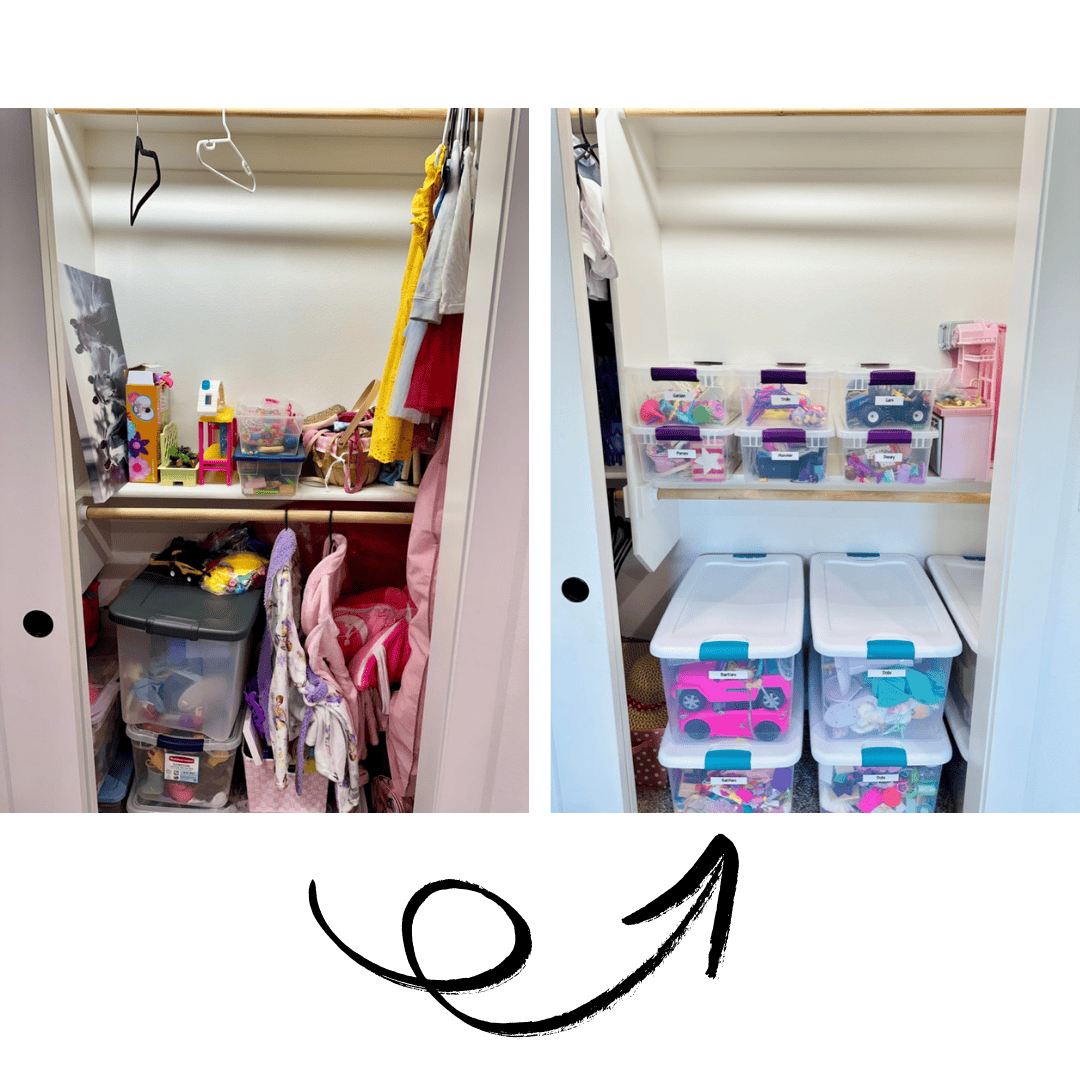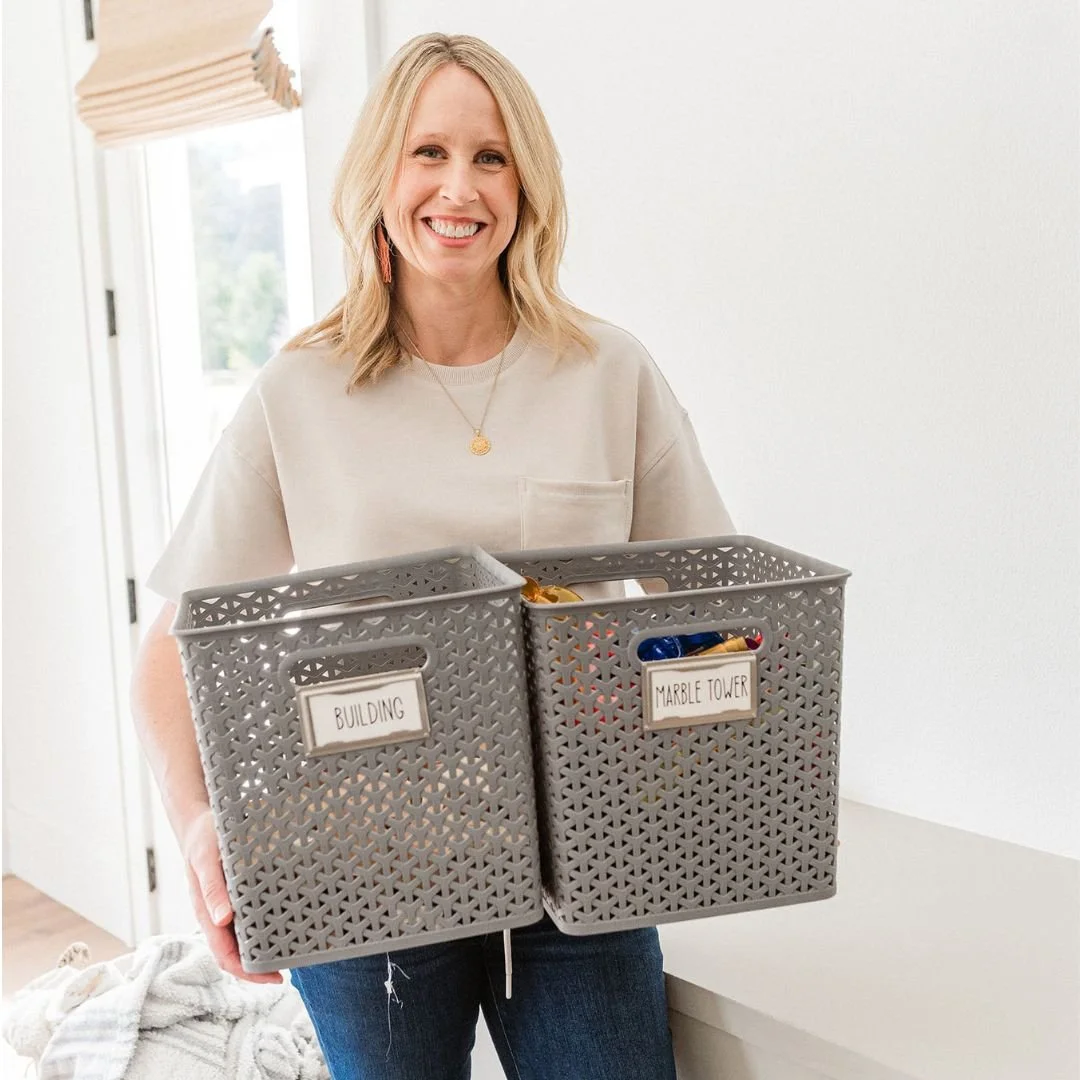A Clutter-Free Kids' Space
If it feels like the toys are taking over your home, know that you are not alone.
Kids are natural collectors: of stuffed animals, rocks, stickers, party favors from their friend’s birthday and random trinkets they find on the sidewalk. But even if you're drowning in art supplies and LEGO bricks, a peaceful, organized space is possible.
You don’t need to overhaul your whole house! You just need a few simple systems, smart storage, and – most importantly – realistic expectations. Let’s walk through the exact strategies I use in client homes to bring order (and breathing room) back to kids’ spaces.
Smart Storage Solutions by Age Group
One of the most important foundations to any successful organizational system is accessibility. (Think: How easy is it to keep this up? Is it too complicated? Does it fit the situation or space?) In this case, the right organizing system starts with your child’s age. We want to make sure that kids can participate in this process and it makes it easier for them to follow the steps.
Toddlers (Ages 1–3)
Use low, open bins that they can reach on their own. I like these bins that make play time and clean up a breeze!
Label bins with pictures instead of words so they can start to learn categories, or try these clear window storage cubes.
For parents, having an organized caddy for diaper changes prevents clutter and keeps everything in one nice and neat place.
Preschoolers (Ages 3–5)
Create a toy rotation system using these clear zipper storage bags (perfect for all of those smaller items!)
Use picture + word labels on bins so they can learn to match words and objects (great to use with these storage cubes!)
Hang hooks for dress-up clothes that are low enough for independent access.
School-Aged Kids (Ages 6–10)
Store like-items together: LEGOs in bins or bags, books on a bookshelf, crafts in lidded boxes.
Create a system for school papers and artwork using zipper bags and filing bins.
Use cubbies or baskets for shoes, bags, and gear they use daily. IKEA has great storage cubbies like this one!
Tweens and Teens (Ages 10+)
Give them more ownership over how they want their space organized!
Store seasonal items or lesser-used belongings in these underbed containers.
Create a dedicated homework station or reading nook they can personalize with organizers like this Lazy Susan style caddy.
Short on space? This lofted bed and desk combo is a great option for maximizing their rooms!
Pro tip: Whatever the age, only keep out what they use now. Outgrown toys, duplicates, or broken items? Time to say goodbye!
Multi-Use Spaces That Work Harder
When your kids’ room, playroom, or shared family space needs to do double (or triple) duty, choose storage and furniture that can adapt.
Play Mat + Storage in One: This ingenious play mat doubles as a storage bag – just pull the drawstring and small toys are contained in seconds. A serious game changer!
Over-the-Door Toy Organizer: Perfect for tight spaces, this over-the-door hanger stores stuffed animals, dolls, or lightweight toys without taking up floor space.
Mobile Toy Bookshelf: A rolling storage bookshelf with separate bins keeps books and toys organized — and you can wheel it wherever play happens!
Floating Shelves for Books: Keep favorites within reach but off the floor using floating wall shelves, freeing up valuable play space below.
These multi-use solutions save square footage while making cleanup a breeze.
Zones & Flow: Organize by Function
The secret to making a kids’ space feel organized? Don’t just sort by category. Design it by purpose.
Create simple zones that reflect how your child uses the space:
Play Zone: Open floor space + bins nearby.
Quiet Zone: Calming lighting, books within reach, and minimal clutter.
Create Zone: Table or desk for crafts, coloring, or building. Include drawer organizers or desktop bins.
Dress Zone: Keep daily clothes in accessible drawers (these drawer organizers are great!). Place a hamper nearby for dirty clothes.
Zones help kids understand where things belong and make transitions between activities much smoother.
Pro tip: Keep a trash can in their rooms! I find that many of my clients get upset when their children have trash in their rooms but no place to put it. Make it easy for them to keep their “zones” tidy by having a trash can nearby.
Maintenance Systems That Actually Work
Once it’s organized, how do you keep it that way? It’s not about being perfect, but doing your best to stay on top of the mess!
Daily: Simple Tidying-Up
Use a cleanup song: 2–5 minutes is all it takes! Find a song everyone loves and make it a game.
Create a routine: Before screen time, after school, before bed – choose a time that works best for your family.
Assign tasks by zone or category so it feels less overwhelming.
Weekly: The Family Reset
Pick one day or time each week where everyone resets their own space. This should be scheduled ahead of time and consistent each week to help reinforce this new habit. Do it together as a family so you can teach your kids how to clean, declutter, and organize. Eventually, they will be able to do it on their own after lots of demonstrations and cues.
Use a timer (this one is great!). Keep it short. Offer support (especially for younger kids) to keep things moving, such as a written list or this magnetic chore chart!
Have a Rotation System
Pack away a portion of the toys and swap them out quarterly or semiannually . This helps keep toy overwhelm to a minimum, and keeps kids occupied with something “new!”!
It creates a “fresh space,” and makes cleanup easier.
Label storage bins clearly so you know what’s inside and hide the bins where your kids won’t get into them.
Realistic Tips for Busy Parents
No time for a full overhaul? No problem. Here’s how to make progress little by little:
Start small. One basket or drawer at a time is a win!
Keep a donation bin near the closet or in the garage, so you can easily pare down items.
Label everything! No need for a fancy label maker (unless you want one! This one is my favorite) Even a roll of painter's tape + Sharpie marker gets the job done.
Don’t aim for Pinterest. Aim for peace.
Remember: it’s not your job to keep every item! It’s your job to create a space that supports your child’s growth and your family’s sanity.
Ready to clean up your kids’ space?
Whether you’re working with a cramped bedroom, a chaotic playroom, or a multi-use space that’s doing a little too much, I can help you create an organizing system that actually works for your family’s routines.
From choosing the right storage to setting up realistic maintenance habits, we’ll build a plan that gives your kids more independence — and you more breathing room.
Book your consultation today and let’s turn your child’s space into one that’s calm, functional, and easy to keep up with!



